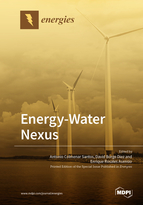Energy-Water Nexus
A special issue of Energies (ISSN 1996-1073). This special issue belongs to the section "B: Energy and Environment".
Deadline for manuscript submissions: closed (31 August 2020) | Viewed by 22704
Special Issue Editors
Interests: energy efficiency; energy economics; renewable energy; energy simulation; energy optimization
Special Issues, Collections and Topics in MDPI journals
Interests: energy efficiency; energy economics; renewable energy; energy simulation; energy optimization
Special Issues, Collections and Topics in MDPI journals
Interests: environment management systems; water desalination; waste-heat-recovery technology; electrical engineering
Special Issues, Collections and Topics in MDPI journals
Special Issue Information
Dear Colleagues,
Water is necessary to produce energy, and energy is required to pump, treat, and transport water. The energy–water nexus examines the interactions between these two inextricably linked elements. This Special Issue aims to explore a single "system of systems" for the integration of energy systems. This approach considers the relationships between electricity, thermal, and fuel systems and data and information networks in order to ensure optimal integration and interoperability across the entire spectrum of the energy system. This framework for the integration of energy systems can be adapted to evaluate the interactions between energy and water. This Special Issue focuses on the analysis of water interactions with and dependencies on the dynamics of the electricity sector and the transport sector.
Prof. Dr. Antonio Colmenar-Santos
Prof. Dr. David Borge Diez
Dr. Enrique Rosales Asensio
Guest Editors
Manuscript Submission Information
Manuscripts should be submitted online at www.mdpi.com by registering and logging in to this website. Once you are registered, click here to go to the submission form. Manuscripts can be submitted until the deadline. All submissions that pass pre-check are peer-reviewed. Accepted papers will be published continuously in the journal (as soon as accepted) and will be listed together on the special issue website. Research articles, review articles as well as short communications are invited. For planned papers, a title and short abstract (about 100 words) can be sent to the Editorial Office for announcement on this website.
Submitted manuscripts should not have been published previously, nor be under consideration for publication elsewhere (except conference proceedings papers). All manuscripts are thoroughly refereed through a single-blind peer-review process. A guide for authors and other relevant information for submission of manuscripts is available on the Instructions for Authors page. Energies is an international peer-reviewed open access semimonthly journal published by MDPI.
Please visit the Instructions for Authors page before submitting a manuscript. The Article Processing Charge (APC) for publication in this open access journal is 2600 CHF (Swiss Francs). Submitted papers should be well formatted and use good English. Authors may use MDPI's English editing service prior to publication or during author revisions.
Keywords
- energy–water nexus
- dynamics of the electricity sector
- dynamics of the transport sector







